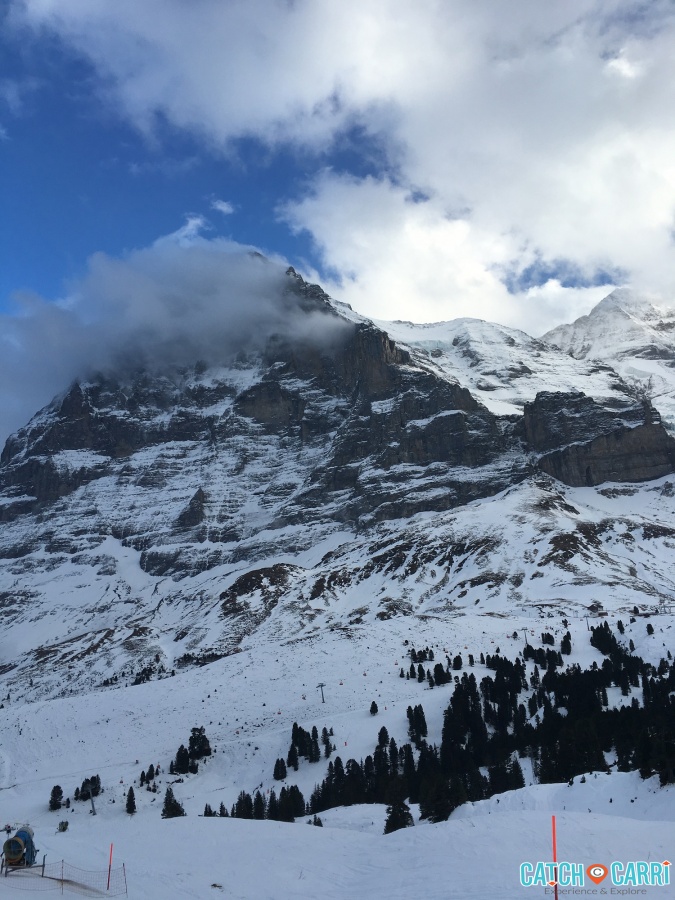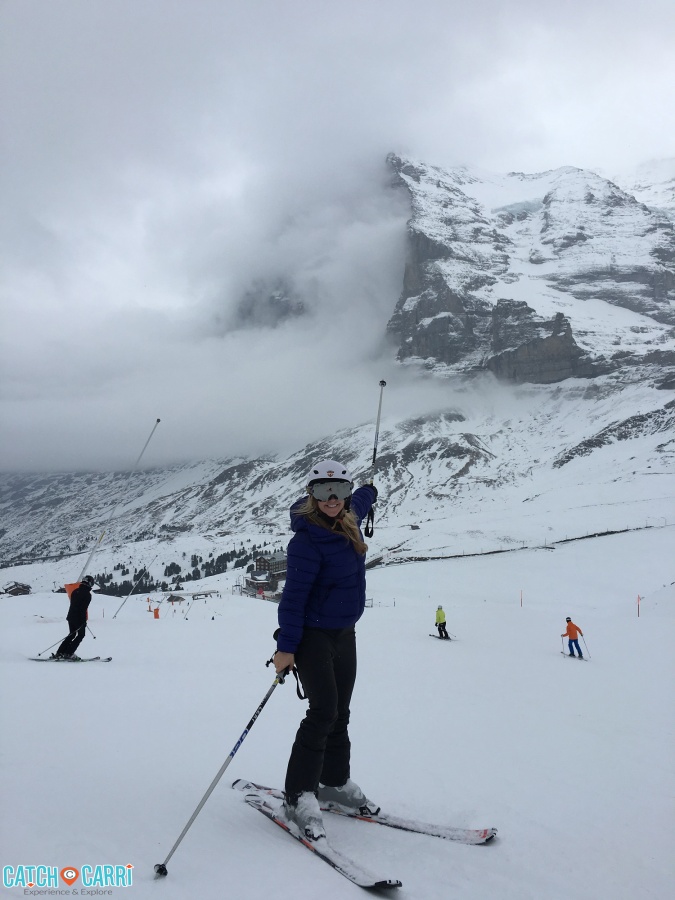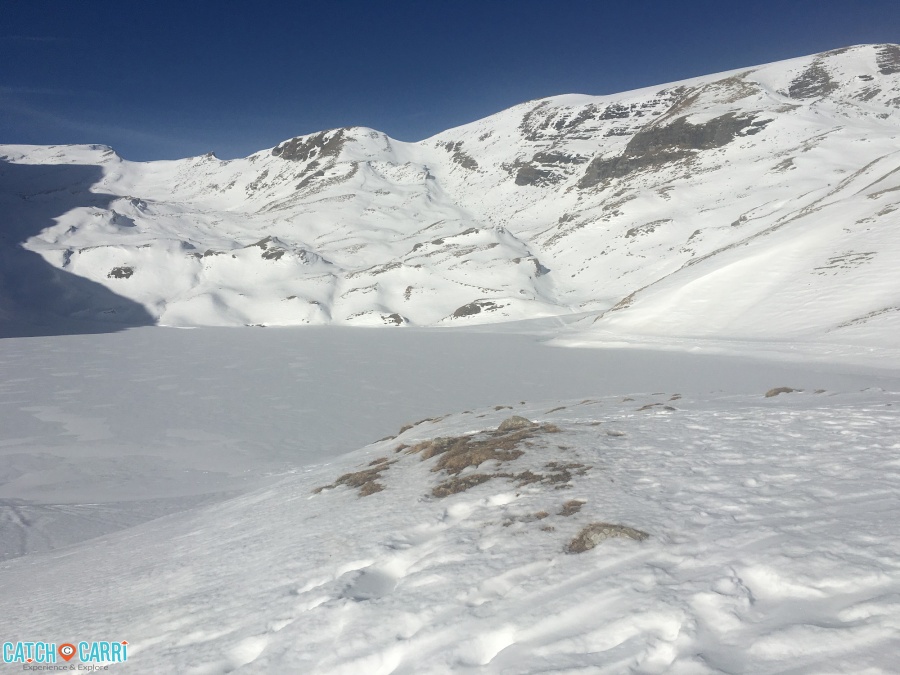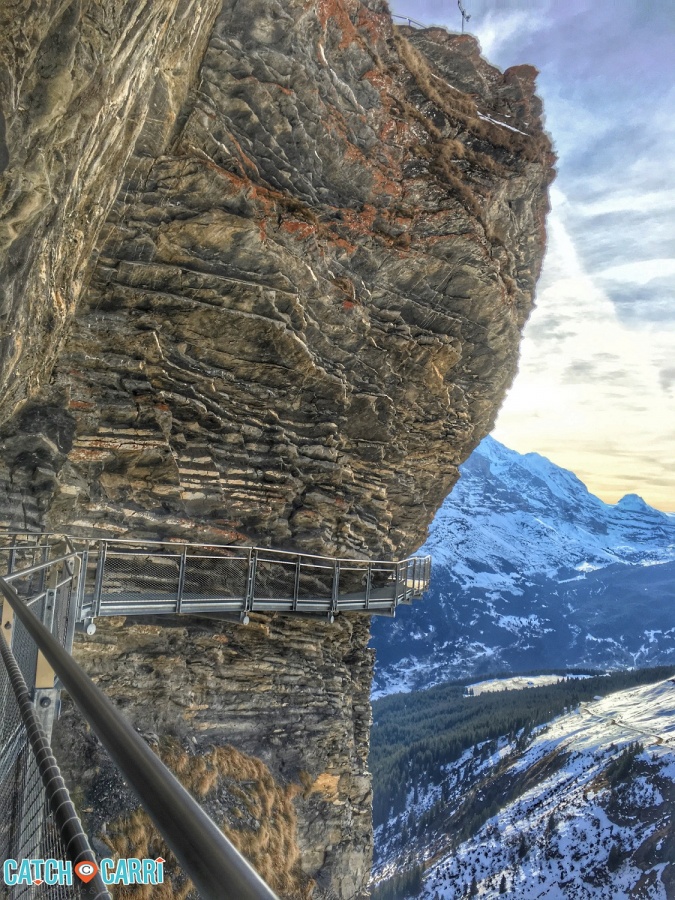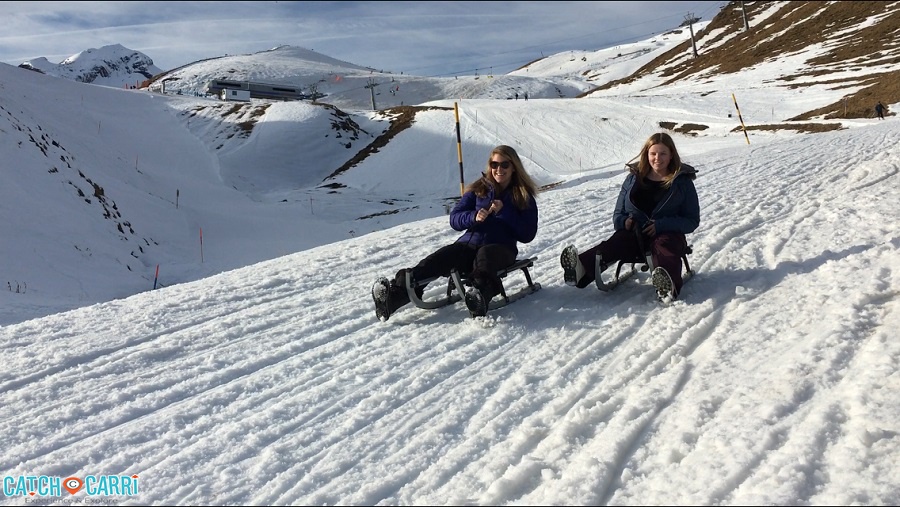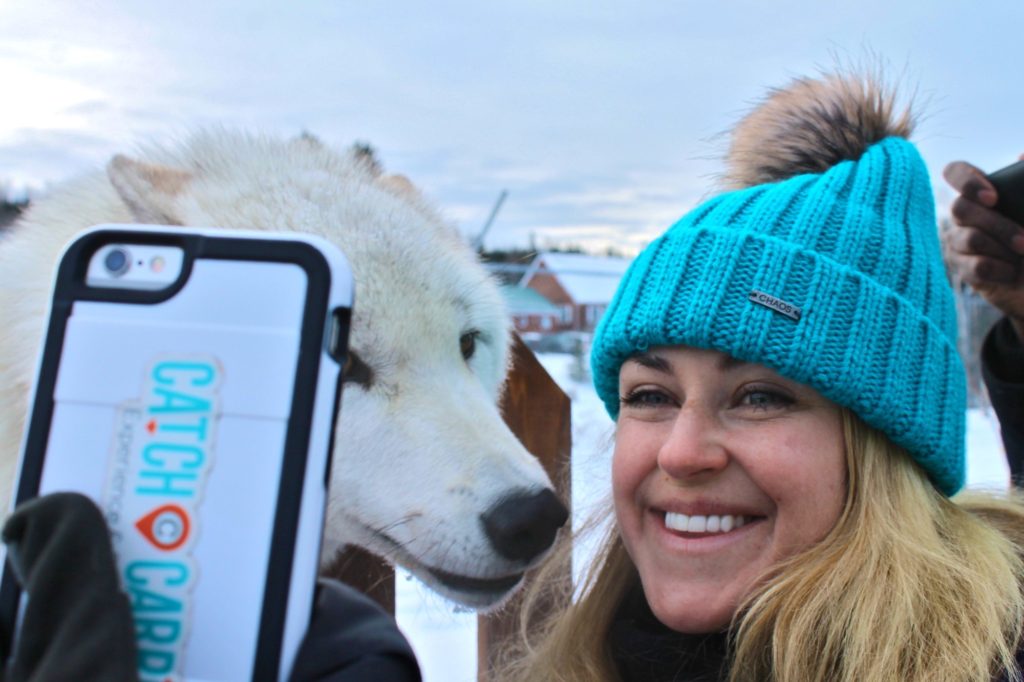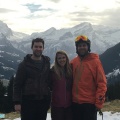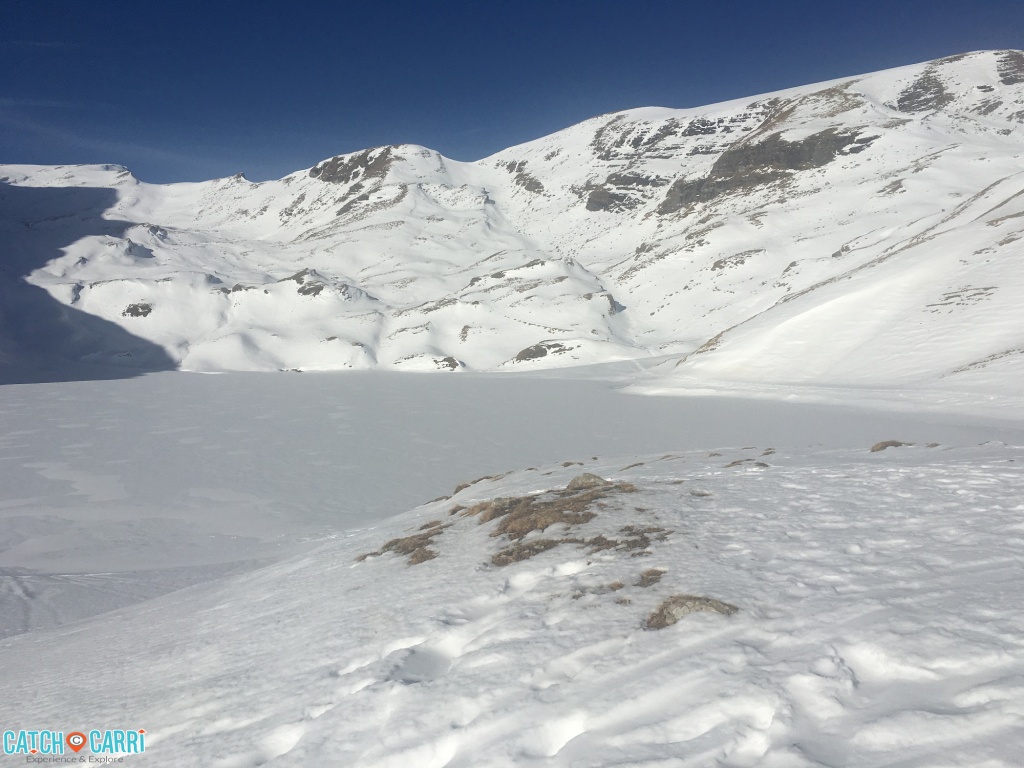
Complete Travel Guide: Grindelwald, Jungfrau Region
One look up after arriving in Grindelwald, Switzerland and I am star struck. And not by a person, but by a mountain made even more mythical with thick clouds rolling across the middle of it. The Eiger’s North Face calls only the most daring climbers and is one not to be taken lightly. Over the centuries, it has claimed the lives of many explorers trying to tackle it. Even with modern climbing equipment and guides today, it’s still a daunting task for experienced and well practiced climbers only. I am no such climber, but it doesn’t make looking at the mountain any less thrilling.
Skiing at the base of Mt. Eiger is a true bucket list item for mountain junkies, and one I did feel comfortable tackling. It’s one thing to see Eiger from a distance (or even paragliding toward it in nearby Interlaken) but when you are skiing at the base, it’s otherworldly. Here, the mass of the mountain- which is one vertical mile of sheer rock and ice- is put in perspective and details like frozen waterfalls come into focus.
This of course is reason enough to plan a trip to Grindelwald, but far from the only. In fact the remote glacier village, named for the gargantuan piles of ice that sit on the Alps above, has plenty more mountain adventures up its sleeve.
Here is a guide to make sure your experience is epic.
The Apex Experience:
1. Skiing at the Base of Mt Eiger
There is simply no question that skiing at the base of Mt. Eiger is the kind of experience you won’t soon (or ever) forget. After a 5-minute bus ride from the Grindelwald Village, a group of four of us hop on ’70s-era red retro gondolas on the Mannlichenbahn lift as we truck towards Kleine Scheidegg-Mannlichen, where there are more than 60 miles to ski and 45 lifts. I squeeze in next to my guide for the day, Adrian, who knows the mountains inside and out. On our way to the top, we pass over a running stream, fox footprints and chalet style homes, some of which belong to cheese makers and farmers.
The gondola ride takes less than 15 minutes, and once we arrive at the top, Adrian and I head off on fresh tracks down towards Lauberhorn, which is a path that takes us straight to the base of the Eiger. This close, the bright white landscape of the mountain changes. I can now see massive glaciers on the mountain and frozen waterfalls frozen to the limestone walls.
We ski a full day, traversing different runs up and down the mountain. We ski down the Kleine Scheidegg-Mannlichen, which I recognize from seeing on TV during the Lauberhorn World Cup Downhill Race. The course is 4.2 km and athletes can reach speeds of up to 99 miles an hour on straighter portions. I do a more modest wide turns, traversing as much of the slope as possible because the runs are much steeper than what I am used to in Colorado. After taking a run down the course, I work up the courage to ask a question I fear may not be met with the response I want, especially considering my ski skills are not black diamond advanced.
“Adrian, do you think we could ski up the Eigergletscher lift?” I ask knowing this could be too advanced of a run, but also the most memorable yet, as it actually swings past the mountain’s base, dropping you off on a run past it.
“Today, I think it’s not possible. It’s too icy,” he tells me through a strong gust of wind.
I was only slightly let down, because I hope it means a trip back for me on a powder day one year. Plus, we have a few more hours skiing with Mt. Eiger always in the corner of my eye.
Cost: One-day lift tickets that cover the First-Kleine Scheidegg–Männlichen areas (plus Wengen) cost 63 SF. A two-day pass costs 115 SF. A two-day pass for the entire region, which adds Mürren and the Schilthorn, costs 140 SF. Ski pass includes busses around town.
As promised earlier, however, skiing is far from the only thing to do in Grindelwald. Now here are some of the other experiences I recommend:
2. Winter Hike
A hike to Lake of Bachlap offers alpine views in a much quieter environment than you will find at Mt. Eiger’s base. The hike, which is about an hour round trip, takes you to two snow-covered lakes that sit by side. On the way, you’re likely to spot wildlife – we saw a mountain goat that stood tall to protect its turf from a few dogs hiking along side us. Bring along some Swiss chocolate and upon arrival at the lake unpack and enjoy with the sun soaked views of the mountains staggered around you. In winter, skiers and boarders often trek up the nearest mountain to the lake for some off piste skiing.
3. First Cliff Hike
Take a walk along this suspended walkway, which is bolted into a rock face on the side of the mountain, for views you won’t see elsewhere. At the end of the short path (just a few steps) you’ll be greeted with straight on views of the Alps. Also make sure to look down, as it sits atop clear glass paneling (which is kind of scary if you’re afraid of heights). My favorite part was ducking below eye level rock shelves that jut out towards the walkway. The walkway starts from the sundeck at Bergrestaurant, a great spot to for a self-service lunch. Here you’ll find warm foods like meatloaf, soups and sausages for 15-20 Swiss Francs.
4. Sledging
Coming from the states, I have tried sledding, and assumed that meant a sledge ride (which is just like a toboggan) would come easily. But this is not actually the case, which I realized after I was atop the run. I rented a sledge from town at Buri Sport (a little cheaper than you will find at places up top) and assumed I would be good to go when it came time to race downhill. But as I sat down on a snow-covered service road and grabbed the roap, I realized just how much different this is than sledding. Here, you have to steer down a winding path and hold tight to a rope while sitting up right, where sledding is basically bombing down a mountain. I took off like a racehorse (ok, this was only in mind) and noticed the sledge didn’t like my steering. It favored the right side of the track, and had I gone too far over and I would have tumbled down a steep hill. If this happens to you, just roll to the left to take down the speed. You can also use your feet as a snow break. Either way, you will have fun and laugh and this is definitely worth a go.
5. Explore the Village
A walk in the charming Swiss chalet style village leads up plenty of shops, restaurants and places for après. One of my favorites is Avocado, a laid back bar that attracts both locals and tourists. It’s a lively spot that’s owned by a former downhill ski racer, Alex, who hails from Australia. Alex came to the area chasing snow sports and fell in love. But he quickly realized the town was missing a welcoming après ski spot, so he decided to stick around and open up Avocado. Inside, you will find both young and old enjoying Swiss beers right off the main drag. And you don’t want to miss seeing the backyard, which has been transformed into a half pipe so mountain junkies can throw tricks even after the lifts close.
Where to Stay: Hotel Hirschen.
This three star boutique hotel in the center of town has been open since 1903. Patrick Bleur is the fourth generation owner and operates the recently updated 28-room hotel. Inside, you will find immaculate rooms that are rustic modern and comfortable.
Pricing: Single rooms: 90 to 140 Swiss Francs. Double rooms: 160 to 220 Swiss Francs and Superior Rooms 200 to 320 Swiss Francs. Rooms include breakfast buffets with slow roasted coffee, eggs made to order, local cheese and bread and fresh squeezed juice.
Halfboard options, which include dinner, are available for an additional charge. On the menu find Swiss Specialties like fondue, raclette and my top pick, Flammkuchen- a thin type of pizza topped with cheese, fresh cream, bacon and onion.
Getting to Grindelwald: By Train: 3.5 hours from Geneva, 2.5 hours from Zurich and 1.5 hours from Bern via Swiss Travel Systems.








